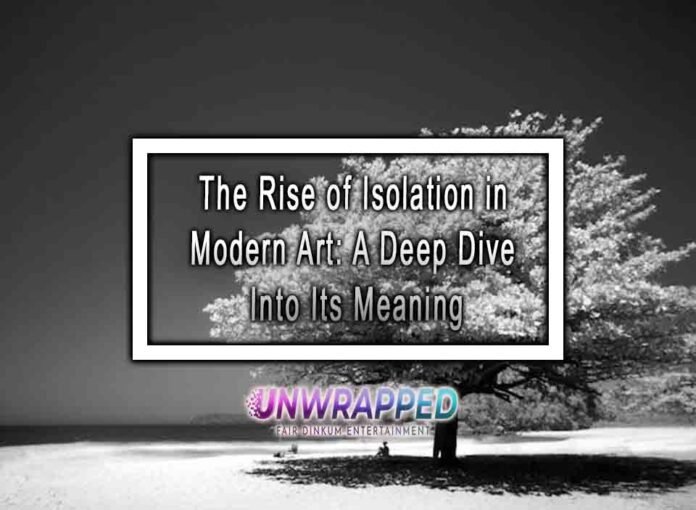Introduction
Isolation, a universal human experience, has become a defining theme for many modern artists. As the world becomes increasingly interconnected through technology, paradoxically, feelings of loneliness and disconnection are on the rise. Artists have turned to their craft to express and explore these emotions, making isolation a prevalent motif in contemporary art. From introspective paintings to thought-provoking installations, the exploration of solitude reveals deeper societal, psychological, and philosophical truths.
Modern art embracing isolation resonates with audiences navigating the challenges of a fast-paced, digitally-driven society. The global COVID-19 pandemic, societal shifts, and the increasing prevalence of remote interactions have amplified the relevance of isolation in artistic discourse. This article delves into why contemporary artists are drawn to this theme, examining its cultural, emotional, and creative implications.
The Historical Context of Isolation in Art
- Isolation as a Timeless Theme:
- Solitude has long influenced art, appearing in works like:
- Edward Hopper’s Nighthawks, symbolizing urban loneliness.
- Vincent van Gogh’s Starry Night, reflecting his emotional struggles during confinement.
- Themes of isolation often emerge during times of societal upheaval, such as wars or pandemics.
- Solitude has long influenced art, appearing in works like:
- From Romanticism to Modernism:
- Romantic painters like Caspar David Friedrich depicted human solitude in vast, dramatic landscapes.
- Modernist movements embraced existentialism, with artists like Edvard Munch exploring alienation and psychological turmoil (The Scream).
Why Modern Artists Are Drawn to Themes of Isolation
- Global Events and Cultural Shifts:
- The COVID-19 Pandemic:
- Lockdowns and social distancing fueled feelings of loneliness, reflected in art addressing isolation and resilience.
- Example: Banksy’s pandemic-inspired graffiti showing a rat stuck indoors.
- Climate Change and Anxiety:
- Environmental degradation fosters a sense of existential isolation from nature and future generations.
- The COVID-19 Pandemic:
- Technological Advancements:
- Digital Disconnection:
- Social media fosters connection but often exacerbates feelings of inadequacy and loneliness.
- Remote Work Culture:
- The shift to virtual interactions has reduced physical human connections, influencing artists to explore digital solitude.
- Digital Disconnection:
- Psychological Exploration:
- Artists use isolation as a lens to examine the self, identity, and existential meaning.
- Example: Yayoi Kusama’s infinity rooms explore themes of vastness and solitude.
- Political and Social Commentary:
- Marginalized communities express isolation caused by discrimination or social exclusion.
- Example: Kara Walker’s works examine racial and historical isolation.
How Isolation Shapes Artistic Expression
- Visual Art:
- Minimalist styles often convey loneliness through empty spaces and muted tones.
- Example: Agnes Martin’s abstract works symbolize the quiet introspection of isolation.
- Installation Art:
- Immersive installations allow viewers to experience solitude.
- Example: Olafur Eliasson’s The Weather Project creates a meditative, solitary environment.
- Photography:
- Photographers capture urban desolation, abandoned places, or solitary figures to evoke emotional detachment.
- Example: Gregory Crewdson’s cinematic photos of eerie, isolated suburban life.
- Literature and Poetry:
- Writers often explore loneliness and existentialism, influencing other artistic mediums.
- Example: Sylvia Plath’s The Bell Jar and its artistic adaptations.
- Digital Art and Virtual Reality:
- Technology enables artists to simulate isolation through VR experiences.
- Example: Virtual art galleries with intentionally sparse interactions replicate the solitude of modern life.
Cultural and Psychological Themes in Isolation Art
- Urban Isolation:
- The loneliness of city life is a recurring theme in contemporary art.
- Example: Edward Hopper’s paintings depict isolated urbanites in cafes or apartments.
- Rural and Natural Solitude:
- Artists contrast the peace of rural isolation with its emotional weight.
- Example: Andrew Wyeth’s Christina’s World portrays a figure physically disconnected from her surroundings.
- Identity and Introspection:
- Solitude enables self-reflection, often depicted in self-portraits or abstract works.
- Example: Frida Kahlo’s self-portraits confront her emotional and physical isolation.
- Existential Themes:
- Art delving into isolation often addresses broader existential questions, like the search for meaning in an indifferent universe.
- Example: Samuel Beckett’s minimalist stage designs evoke existential emptiness.
Therapeutic Aspects of Isolation Art
- Art Therapy for Solitude and Loneliness:
- Engaging with isolation-themed art helps viewers confront and process their own feelings of loneliness.
- Example: Participatory art projects encourage individuals to create art inspired by their solitary experiences.
- Healing Through Shared Experience:
- Isolation-themed art reminds viewers that they are not alone, fostering empathy and connection.
- Meditative and Reflective Art:
- Art installations and minimalist designs offer spaces for introspection and mental relaxation.
Examples of Artists and Works Focusing on Isolation
- Edward Hopper:
- Known for capturing urban isolation in works like Automat and Nighthawks.
- Yayoi Kusama:
- Infinity Mirror Rooms explore themes of isolation within the vastness of the universe.
- Agnes Martin:
- Her minimalist abstract paintings reflect solitude and quiet introspection.
- Banksy:
- Recent works highlight isolation during the pandemic and societal disconnection.
- Gregory Crewdson:
- Cinematic photography reveals eerie suburban solitude.
The Future of Isolation in Art
- Post-Pandemic Reflection:
- Artists will continue to explore how isolation has reshaped relationships, identity, and society.
- Blending Technology and Solitude:
- Virtual and augmented reality experiences will expand on the theme of isolation.
- Global Connectivity vs. Local Solitude:
- Artists may juxtapose global hyper-connectivity with the personal isolation it often causes.
Conclusion
Modern artists are increasingly embracing themes of isolation, reflecting the challenges and complexities of contemporary life. By engaging with this universal experience, art serves as both a mirror and a balm, offering insights into the human condition while fostering connection and empathy.
Through various mediums and styles, these creators transform solitude into a shared exploration of identity, resilience, and emotional depth. As society evolves, so too will the art inspired by isolation, ensuring its relevance for generations to come. In exploring these works, audiences not only confront their own feelings of loneliness but also find solace in knowing they are part of a shared human narrative.
See Also: How Dark Art Influences Emotion and the Human Psyche










